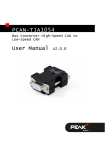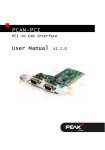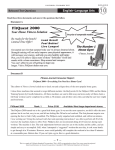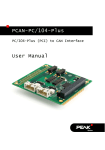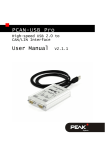Download PCAN-B10011S - User Manual - PEAK
Transcript
PCAN-B10011S Bus Converter High-speed CAN to Truck Trailer CAN User Manual Document version 2.1.0 (2013-11-15) PCAN-B10011S - User Manual Products taken into account Product Name Model Part number PCAN-B10011S IPEH-002041 CANopen® and CiA® are registered community trade marks of CAN in Automation e.V. All other product names mentioned in this document may be the trademarks or registered trademarks of their respective companies. They are not explicitly marked by “™” and “®”. © 2013 PEAK-System Technik GmbH PEAK-System Technik GmbH Otto-Roehm-Strasse 69 64293 Darmstadt Germany Phone: +49 (0)6151 8173-20 Fax: +49 (0)6151 8173-29 www.peak-system.com [email protected] Document version 2.1.0 (2013-11-15) 2 PCAN-B10011S - User Manual Contents 1 1.1 1.2 1.3 2 2.1 2.2 2.3 3 3.1 3.2 3.3 4 4.1 4.2 4.3 5 Introduction 5 Properties at a Glance System Requirements Scope of Supply Installation 5 6 6 7 Connector High-speed CAN Side Connector Truck Trailer CAN Side Power Supply Operation 7 8 9 10 CAN Bit Rate Listen-only Mode Master/Slave 10 10 11 Communication Problems 13 Red LED “Error” Adjusting the Internal System Voltage Single-wire Operation Modes Technical Specifications 13 14 15 17 Appendix A CE Certificate 19 Appendix B Dimension Drawing 20 Appendix C Quick Reference 21 3 PCAN-B10011S - User Manual Module Elements Low-voltage socket on page 9 Termination High-speed CAN on page 7 Connector High-speed CAN on page 7 Internal system voltage on page 14 Master/Slave on page 11 Listen-only mode on page 10 Error indicator Truck Trailer CAN on page 13 Connector Truck Trailer CAN on page 8 Power indicator on page 9 4 PCAN-B10011S - User Manual 1 Introduction Tip: At the end of this manual (Appendix C) you can find a Quick Reference with brief information about the installation and operation of the PCAN-B10011S. The PCAN-B10011S bus converter establishes a connection between a high-speed CAN bus (ISO 11898-2) and a Truck Trailer CAN bus (ISO 11992-1). One of the most important potential applications of the bus converter is a simple connection between a PEAK CAN interface (e.g. PCAN-USB) and a Truck Trailer CAN bus. Truck-Trailer CAN is a communication connection used between a towcar and its trailers. The special conditions of this environment are taken into account, like long wires, high levels of disturbance, high voltage deviation, and a small amount of data. A Truck Trailer CAN bus has at least two nodes. The connection is done with a two-wire line. The power supply may be done locally or via the cable from the towcar, where the reference point is the bodywork. Bodyworks from the towcar and the trailer are connected with each other. Due to this configuration there are potential differences and disturbances Truck Trailer CAN is optimized for. 1.1 Properties at a Glance Direct connection to a High-speed CAN bus through a D-Sub connector, 9-pin with switchable termination Direct connection of the Truck Trailer CAN bus through a D-Sub connector, 9-pin with switchable termination (master/slave mode) Normal or listen-only operating mode 5 PCAN-B10011S - User Manual Bit rates up to 125 kbit/s (limited by input filter) Power supply via the Truck Trailer CAN bus or self-sufficient with power supply unit Adjustable Truck Trailer system voltage (11 - 26 V) for power through mains power pack Status display for power supply and error states via LEDs Extended operating temperature range from -40 to +85 °C (-40 to +185 °F) 1.2 System Requirements Voltage supply (usually 24 V DC) via the Truck Trailer CAN connector (see section 2 Installation on page 7) - or Voltage supply with the delivered power supply unit 1.3 Scope of Supply Adapter in plastic casing Power supply unit Manual in PDF format 6 PCAN-B10011S - User Manual 2 2.1 Installation Connector High-speed CAN Side The PCAN-B10011S is designed for direct connection to a CAN interface of the PCAN series (e.g. PCAN-USB). The pin assignment corresponds to the specification CiA® 102. Figure 1: Pin assignment of the High-speed CAN connector Between the lines CAN_L and CAN_H a switchable termination with a resistance of 120 Ω is installed internally. If the PCAN-B10011S shall not be connected directly to a CAN interface of the PCAN series and shall not become the endpoint of a High-speed CAN bus, the termination can be set inoperable with the corresponding slide switch (see figure and table). 7 PCAN-B10011S - User Manual Termination High-speed CAN 120 Ω Switch position left none right Figure 2: Switch for High-speed CAN termination 2.2 Connector Truck Trailer CAN Side For the connection of the Truck Trailer CAN bus a 9-pin male D-Sub port is used. Figure 3: Pin assignment of the Truck Trailer CAN connector Optionally the voltage supply of the PCAN-B10011S can be done via VBAT (pin 9) (see following section). 8 PCAN-B10011S - User Manual 2.3 Power Supply The PCAN-B10011S can be supplied either via the Truck Trailer CAN connector (VBAT, pin 9) or independently via the low-voltage socket (e.g. with the power supply unit). The DC voltage should be 24 Volts. Figure 4: Contact assignment of the low-voltage socket Note: A simultaneous connection of both supply ways isn't problematic, because the power supply with the higher voltage (usually the one of the power supply unit) is used automatically because of the circuit design. It is ensured that current cannot flow from one power supply to the other. In principle higher or lower input voltages than 24 V may be applied (8 – 30 V). However, communication errors may occur at high potential differences to system voltages of other Truck Trailer CAN nodes. You can find hints for solving those problems in section 4.2 Adjusting the Internal System Voltage on page 14. The green LED on the casing of the PCAN-B10011S indicates an existing power supply. 9 PCAN-B10011S - User Manual 3 Operation When putting the PCAN-B10011S into operation, please observe the following sections. 3.1 CAN Bit Rate When operating the PCAN-B10011S, it must be ensured that the bit rate on the High-speed CAN bus matches the one on the Truck Trailer CAN bus. No conversion or automatic adaptation of the bit rate is done in the bus converter. The maximum bit rate is 125 kbit/s (limited by input filter). 3.2 Listen-only Mode During the active operation mode (normal case) the PCAN-B10011S can both receive as well as transmit on the Truck Trailer CAN side. For monitoring the CAN traffic without affecting it the setting for the passive operation is applicable (listen-only mode). In this case the transmission unit of the PCAN-B10011S is disconnected from the Truck Trailer CAN. Also the acknowledgement signal (ACK bit) typically used by CAN is not transmitted. Note: For a simple point-to-point connection between two nodes both must be able to receive and transmit. Therefore only the active operation works in this case. 10 PCAN-B10011S - User Manual The listen-only mode is set with the corresponding slide switch (see figure and table). Operation mode Switch position Normal Listen-only right left Figure 5: Switch for listen-only mode 3.3 Master/Slave At least one node must be configured as master on a Truck Trailer CAN bus. The master determines the signal levels for communication on the bus. Further nodes on the bus being configured as slaves automatically adapt to the given signal levels and are then able to transmit, too. In principle, several nodes may operate as master. If, however, the signal levels of the masters differ due to different battery voltages or potentials, communication errors may occur. The system voltage of the PCAN-B10011S can be adjusted when supplied by the power supply unit. See section 4.2 Adjusting the Internal System Voltage on page 14. 11 PCAN-B10011S - User Manual The selection between master and slave operation is done with the corresponding slide switch (see figure and table). Operation mode Master Slave Figure 6: Switch for Master/Slave 12 Switch position left right PCAN-B10011S - User Manual 4 Communication Problems This section is dealing with the detection of communication problems and the possibilities of adjustments and settings for the PCAN-B10011S to analyze those problems and solve them. Tip: You can find additional information about the properties and the behavior of the Truck Trailer CAN transceiver B10011S in the corresponding data sheet, which you can download from the Atmel website (www.atmel.com). 4.1 Red LED “Error” The red LED indicates the state of the error output of the Truck Trailer CAN transceiver. This output is active for the following error conditions on the Truck Trailer CAN side: Interrupt on CAN_H Interrupt on CAN_L Short circuit between CAN_H and GND Short circuit between CAN_H and VCC Short circuit between CAN_L and GND Short circuit between CAN_L and VCC Transient disturbance caused by an overvoltage pulse between CAN_L and CAN_H (e.g. when switching an inductive load) 13 PCAN-B10011S - User Manual 4.2 Adjusting the Internal System Voltage Due to differences in the potentials between parts of bodyworks or differences of system voltages of the nodes a communication may be detected as faulty or the communication may be impossible at all. When the PCAN-B10011S is supplied via the low-voltage socket, you have the possibility to adjust the internal system voltage to the conditions on the bus (usually by decreasing the voltage). This is done with the trimmer. + V – Figure 7: Trimmer for system voltage At delivery the trimmer is pre-adjusted so that the internal system voltage is 24 V when using the provided power supply unit. The voltage can be varied in the range of about 11 to 26 V. Note: Before adjusting the internal system voltage, make sure that the occurring communication problems are not an effect of short circuits or line interruptions. Furthermore, a single-wire operation mode should not be active (see following section Single-wire Operation Modes). Do the following to adjust the internal system voltage: For decreasing the voltage turn the trimmer clockwise until the communication errors are not occurring anymore and the red LED goes off. 14 PCAN-B10011S - User Manual 4.3 Single-wire Operation Modes Usually the Truck Trailer CAN transceiver works with the two data lines CAN_L and CAN_H. For testing or verification a single-wire operation can be set up (communication only via line CAN_L or CAN_H). This is done with two Dip switches on the circuit board of the PCAN-B10011S. Do the following to set up the single-wire operation: In order to access the Dip switches you must open the casing of the PCAN-B10011S. With a flat tip screwdriver separate the upper and lower casing parts by carefully pressing into the four gaps and lever the casing open. Figure 8: Position of the Dip switches on the circuit board You can find the possible setup combinations of the Dip switches (S2-1, S2-2) in the following table. Pay attention to the labels on the Dip switch block. Operation mode S2-1 S2-2 Normal off off Single-wire CAN_L ON off Single-wire CAN_H off ON Transceiver not operational ON ON 15 PCAN-B10011S - User Manual Note: If one of the operation modes beside “Normal” is set, the red LED indicates an error (see also section 4.1 Red LED “Error” on page 13). 16 PCAN-B10011S - User Manual 5 Technical Specifications Power supply Supply voltage 24 V DC nominal, 8 - 30 V DC possible Current consumption about 35 mA (at 24 V) max. 110 mA High-speed CAN Specification ISO 11898-2 CAN specifications 2.0A and 2.0B Transceiver PCA82C251 Connector D-Sub socket, 9-pin, pin assignment according to specification CiA® 102 Termination 120 Ω (switchable) Truck Trailer CAN Specification ISO 11992 Transceiver B10011S Connector D-Sub plug, 9-pin Operation modes Master/Slave, Normal/Listen-only Bit rate max. 125 kbit/s (limited by input filter) Measures Size 79 x 43 x 22 mm (L x W x H) See also dimension drawing in Appendix B on page 20 Weight 42 g 17 PCAN-B10011S - User Manual Environment Operating temperature -40 - +85 °C (-40 - +185 °F) Temperature for storage and transport -40 - +100 °C (-40 - +212 °F) Relative humidity 15% - 90%, not condensing EMC EN 55024:2011-09 EN 55022:2011-12 EC directive 2004/108/EG Ingress protection (IEC 60529) IP20 18 PCAN-B10011S - User Manual Appendix A CE Certificate 19 PCAN-B10011S - User Manual Appendix B Dimension Drawing Top view and side view PCAN-B10011S. The figure does not show the original size. 20 PCAN-B10011S - User Manual Appendix C Quick Reference High-speed CAN Socket Truck Trailer CAN Plug Low-voltage Socket 24 V DC nominal, 8 - 30 V DC possible Slide Switches High-speed CAN termination 120 Ω | termination off Truck Trailer CAN: Master | Slave Truck Trailer CAN: Listen-only | Normal Status LEDs Green “Power” Red “Error” Voltage supply Error condition on the Truck Trailer CAN bus 21























